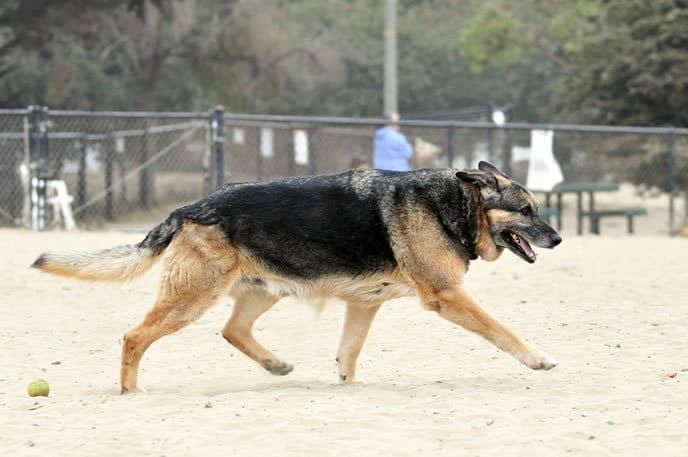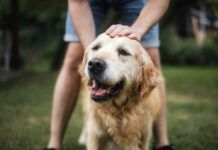Sometimes we don’t want to admit our dog is aging. We ignore the graying muzzle and scoff at the idea of a “senior dog food.” After all, we’re both still running and playing and having fun . . . who’s old? But the truth of the matter is that the best thing we can do for our dogs and for ourselves is look aging right in the face. We need to become highly tuned to the subtle changes in our dog’s behavior and receptive to ways to improve his life – and ours.
You can employ the following 10 management and lifestyle changes to help your senior dog live longer and more comfortably, so you can both thoroughly enjoy his remaining years.

1. Increase your home’s accessibility to limited-mobility dogs.
We didn’t immediately pick up on one of the first signs of aging in our Papillon, Raven: his increasing reluctance to enter or cross through our kitchen. He’d always been happy to walk into it before! It finally occurred to us that his issue had to do with the flooring. We placed a non-skid carpet runner in the kitchen, and Raven again trots happily into and through the room. We hadn’t thought of his age as old enough for this to be the cause of his apprehension, but, clearly, it was!
Puppies seem to enjoy slipping and sliding on slippery floors, but any little slip may spell significant pain for senior dogs, so much so that they begin to avoid uncarpeted or especially smooth flooring. At this time in your dog’s life, it’s important to stop and address these potential sources of his discomfort.
Another typical problem involves heights, such as climbing stairs or hopping in and out of the car. If your dog has always enjoyed rides in the car in the past, but begins hanging back when you pick up your car keys, consider getting a portable ramp! There are a number of companies that offer dog/car ramps that fold or telescope out of the way when they’re not in use.
Before you purchase one, though, take the time to measure your car; don’t guess, because you could end up with a ramp angle that is too steep or difficult for your dog. Petclassics.com, an online source of ramps and steps for older dogs, provides a handy chart that shows how long a ramp needs to be in order to provide a navigable angle for cars of various heights. For example, it shows that if your car is 22 inches high, you’d need a 6-foot ramp in order to achieve a fairly easy 18-degree ramp angle for your older dog. Some of the far shorter ramps on the market won’t help matters at all.
2. Provide your senior dog with regular exercise.
This becomes more and more important as your dog ages. Moderation is key. Too much and problems can worsen; too little won’t support muscle development. “Regular walks and park visits help keep your dog’s muscles strong and supple, prevent obesity, or stimulate her appetite as needed, as well as improve her mood and prevent anxiety and boredom,” says Jenny Taylor, DVM, owner of the Creature Comfort Holistic Veterinary Center in Oakland, California.
3. Buckle up when riding in the car.
By the way, if you’re driving your dog to your favorite hiking trail or park, be sure to use a safe seat belt and harness when driving with your dog. “Many older dogs are mellow and used to car rides but still need protection in the car for even the shortest drives,” says Dr. Taylor. (See “Our Safety Harness Recommendation,” WDJ January 2015.)
4. Provide your dog with better protection from weather extremes.
Discomfort with extreme weather may surface in your dog’s senior years, even if he’s never had a problem with heat or cold before. In winter, he may benefit from a fleece blanket and dog boots (for snow or ice). Indoors, consider a Back on Track coat (see “A Healing Coat,” February 2015), which offers double the bang for your buck, helping to keep him warmer in the house and sending that warmth back into his achy body, helping with musculoskeletal stiffness.
In the summer, be sure your dog can get into shade and has fresh, cool water. There are cooling coats and beds on the market – many of which do a good job – but a simple hosing can be welcome relief when he’s hot (indicated by panting with a very wide tongue). Be sure to hose the dog’s underside, especially the groin area; wetting only his coat will do little to cool him and may even make him temporarily warmer. Kiddie pools can be great fun, too, especially for water-loving dogs like Labradors.
5. Provide a better bed for your aging dog.
Many young dogs happily sprawl out on the floor – even hardwood floors! – and dream away. As your dog ages, though, he’s more likely to become stiff from snoozing on such unforgiving surfaces. It’s time to consider a super-thick orthopedic dog bed. A thick, warm bed provides a lot of joint support and comfort to an aching body.
6. Spring for some supportive canine therapy.
“If your older dog is limping or seems stiff and painful, there are a number of effective, safe, natural alternatives to conventional pain medication for her pain,” says Dr. Taylor. The following alternative veterinary treatments are growing in popularity because they work without the side effects sometimes caused by prescription pain medications:
– Laser therapy is a cost-effective way to put the bounce back in your senior’s walk. With a class IV cold-laser device, your veterinarian can treat acute and chronic injuries, arthritis, muscle pulls, and other sources of pain. Laser therapy can also promote healing after surgery or an injury. As an overall therapy, the cost should is reasonable. Some clinics even offer package-session discounts. But shop around, as we’ve seen huge variations in cost among local veterinary clinics.
– Even dogs who don’t like water learn to love hydrotherapy, which may include swimming in a warm pool and underwater treadmill work. Benefits are widespread: relieving pain without stressing joints, building cardiovascular health and core strength, helping with proprioception and body awareness.
– Acupuncture can give the dog a better sense of well being, especially with chronic problems. Veterinarians see success with acupuncture in cases of neurologic disorders, musculoskeletal problems, respiratory ailments, gastrointestinal problems, and more. Only very fine needles are used in acupuncture, and most dogs take to it very well, some even sleeping during a session. (See “Using Veterinary Acupuncture,” Nov. 2013.)
– Veterinary physical therapy (PT) is an excellent choice – if you can get in for an appointment. The field is exploding as demand is huge. Animal PT is all about helping the patient regain body function, just as it is in human PT. Under the direction of a veterinarian, a good physical therapist will focus on your dog’s individual needs, offering a rehab program tailored to his problem. It may include physical therapy, hydrotherapy, therapeutic massage and exercise, joint mobilization, and more. With an active owner who maintains the required home therapy between sessions, PT can make a world of difference.
7. Add supplements to your senior dog’s diet.
There are a few supplements that are especially beneficial for senior dogs. Fish oil is widely recommended by veterinarians for its many benefits, including healthy coat and skin and joint support. (See “The Benefits of Fish Oil to Your Dog’s Health,” September 2012.) For moderate arthritis, use dosages that are at the higher end of label recommendations.
A combination glucosamine and chondroitin supplement is the most frequently recommended one for arthritic dogs. Don’t wait until your older dog becomes stiff before trying it, though; these products work better as preventives than as therapies. Note: If your dog is allergic to shellfish, check the label, as many of these supplements are sourced from shellfish.
The trick is to ensure your dog consumes enough of the active ingredients to get the job done. The dosage varies with the dog’s weight and the supporting ingredients in the product, but you want a generous “loading dose” (about twice the normal dosage) to begin with, at least about 500 mg glucosamine and 400 mg chondroitin per 25 pounds of the dog’s body weight, given twice a day. This jump-starts results, so you should begin to see improvement in a couple of weeks; at that point, you may be able to decrease the dosage and maintain the supplement’s efficacy.
Don’t count on your dog’s food to supply joint-support supplements, even if the bag label lists glucosamine or a similar ingredient. Compare the guaranteed dosage on the food label with the suggested dosage above; rarely do these foods contain enough of these ingredients to make a real difference to your dog.
Another supplement to consider is hyaluronic acid (HA), a major component of the lubricating fluid in your dog’s (and your own!) joints. It’s the new kid on the block for joint support, and one that many veterinarians are excited about. Originally used as a joint injection, an oral supplement of HA increases the presence of HA and the synovial fluid viscosity, making movement smoother. Some veterinarians find that liquid HA supplements, like Trixsyn, provide faster, more reliable relief than powdered products, although both produce results.

8. Practice good grooming.
We all know our dogs need to be groomed regularly, but your geriatric pal may need some special help. If your dog comes in from relieving himself with debris remaining on his behind, consider a closer haircut back there the next time you clip him or have him groomed.
By the way, the most important part of a good grooming session may be checking your dog’s nails for excess growth and clipping them (or having them clipped, if you are unwilling or unable to do it). Even a dog who “never needed a nail trim” in his youth may need to be clipped. That’s because the nails get less wear with his naturally lower level of activity. Long nails can cause pain to your dog and make him reluctant to exercise, starting a downward cycle of health.
9. Do a lump-and-bump check when you groom your dog.
If you become familiar with your dog’s normal body, you will more quickly notice new growths. This is critical, as the incidence of growths increases as your dog ages. The sooner you catch a bump, the better. If it must be removed, the smaller the spot, the easier the surgery and the faster your dog will heal. Yes, a lump might be a harmless fat deposit, but it could also be a malignant growth.
10. Adjust his diet.
All aging dogs benefit from food that’s easier to digest, and many need you to reduce their caloric intake to maintain a healthy body weight. “Weight gain can make it more difficult for your older dog to walk, stand, or jump, and reluctant to go on walks,” said Dr. Taylor.
That said, if you have to feed your dog a lot less than the amount recommended on his food’s label, in order to limit his caloric intake, he may not be consuming optimal levels of vitamins and minerals, and a supplement may be needed to make up the difference. Discuss this option with your veterinarian, as adding something you don’t need is hard on your wallet – and your dog.
Your senior dog may also need you to wet his food to help avoid constipation, or to make it easier to chew. A switch from dry to canned food can improve matters greatly for many senior dogs, thanks to its increased moisture content (good for kidneys) and higher-quality protein sources.
Finally, if your senior dog’s appetite wanes, he’s probably not being “picky,” but suffering from a growing health problem. Report this to your veterinarian.
Freelance writer Cynthia Foley is an experienced dog agility competitor. She lives in upstate New York.







What is the issue number of this?
My school doesn’t offer it in the school archives and I really wanted to use it but I cant cite it as a journal without an issue number and I cans subscribe just for one magazine.
Wow!! really great tips to make happy dog. Senior dog needs love. patience, and understanding are the key to his heart, and treating him with respect is a must.
I wish they had referenced Wobenzym under the supplements list. It really has made a life-altering beneficial difference to my senior dachshund recovering from inflammation in her cervical spine (along with chiropractic, cold laser therapy, and conventional pain meds in moderation.)
This is a very heartwarming article as it’s so important to nurture and give extra love to your senior dogs. I saw that this article recommended adding supplements and I cannot agree with that more! I have been giving my 10 year old Maltese an all in one multivitamin from the brand balanced breed and it helps him a lot with arthritis